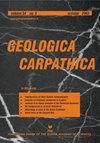东喀尔巴阡弯带(Sibiciu de Sus)中新世下硅藻土烃源岩潜力及古环境
IF 1.5
4区 地球科学
Q4 GEOSCIENCES, MULTIDISCIPLINARY
引用次数: 2
摘要
硅藻土是世界上许多盆地中丰富的烃源岩。在更广阔的喀尔巴阡山脉,成岩蚀变硅藻土被称为细粒岩,细粒岩页岩序列被认为是该地区最丰富的烃源岩。废弃的Sibiciu de Sus采石场位于罗马尼亚的东喀尔巴阡弯曲带,提供了下中新世上蒙利岩上部的大量暴露物,由各种硅藻土岩性、燧石、蒙利岩页岩和富含石英的砂岩组成。由于软沉积变形和随后中新世至上新世的收缩构造,沉积物高度变形。为了(a)确定烃源岩潜力,(b)记录硅藻组合,(c)解释沉积环境,对22个含硅藻样品进行了检查。所研究岩石的烃潜力被认为是好到非常好,平均TOC为3.77 wt. %(最大)。9.57 wt. % TOC)和II-III型干酪根(平均HI: 384 mg HC/g TOC)。Tmax不超过424℃,表明有机质热不成熟。尽管如此,生产指数仍然很高(0.1-0.3),这证明了运移烃的存在。源电位指数(SPI)表明,暴露剖面成熟后可产生约1.3 t HC/m2。由于硅藻保存不允许化学提取单个阀门,本研究仅描述属水平的发现。硅藻组合以Aulacoseira和放线菌属(Actinocyclus)为主,Ellerbeckia、Paralia和Rhaphoneis较为少见。硅藻组合表明近岸微咸水沉积环境。本文章由计算机程序翻译,如有差异,请以英文原文为准。
Hydrocarbon source rock potential and paleoenvironment of lower Miocene diatomites in the Eastern Carpathians Bend Zone (Sibiciu de Sus, Romania)
Diatomites are prolific hydrocarbon source rocks in many basins worldwide. In the broader Carpathians, diagenetically altered diatomites are called menilites, and menilitic shale successions are regarded as the most prolific hydrocarbon source rocks in the region. The abandoned Sibiciu de Sus quarry, located in the Eastern Carpathian Bend Zone of Romania, provides large exposures of the upper part of the Lower Miocene Upper Menilites, composed of various diatomite lithologies, cherts, menilitic shales and quartz-rich sandstone. The sediments are highly deformed due to soft-sediment deformation and subsequent Miocene to Pliocene contractional tectonics. Twenty-two diatom-bearing samples were examined in order (a) to determine the hydrocarbon source rock potential, (b) to document the diatom assemblages and (c) to interpret the depositional environment. The hydrocarbon potential of the studied rocks is considered good to very good, with an average TOC of 3.77 wt. % (max. 9.57 wt. % TOC) and type II–III kerogen (avg. HI: 384 mg HC/g TOC). Tmax does not exceed 424 °C suggesting that the organic matter is thermally immature. Despite that, the Production Index is high (0.1–0.3), which proves the presence of migrated hydrocarbons. The source potential index (SPI) indicates that the exposed section, if mature, could generate about 1.3 t HC/m2. As the diatom preservation does not enable chemical extraction of individual valves, this study describes only genus-level findings. The diatom assemblages are dominated by Aulacoseira and Actinocyclus, whereas Ellerbeckia, Paralia and Rhaphoneis are rarely observed. The diatom assemblages indicate a nearshore, brackish-water depositional setting.
求助全文
通过发布文献求助,成功后即可免费获取论文全文。
去求助
来源期刊

Geologica Carpathica
地学-地球科学综合
CiteScore
2.40
自引率
23.10%
发文量
26
审稿时长
>12 weeks
期刊介绍:
GEOLOGICA CARPATHICA covers a wide spectrum of geological disciplines including geodynamics, tectonics and structural geology, volcanology, stratigraphy, geochronology and isotopic geology, karstology, geochemistry, mineralogy, petrology, lithology and sedimentology, paleogeography, paleoecology, paleobiology and paleontology, paleomagnetism, magnetostratigraphy and other branches of applied geophysics, economic and environmental geology, experimental and theoretical geoscientific studies. Geologica Carpathica , with its 60 year old tradition, presents high-quality research papers devoted to all aspects not only of the Alpine-Carpathian-Balkanian geoscience but also with adjacent regions originated from the Mediterranean Tethys and its continental foreland. Geologica Carpathica is an Official Journal of the Carpathian-Balkan Geological Association.
 求助内容:
求助内容: 应助结果提醒方式:
应助结果提醒方式:


